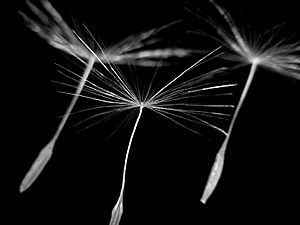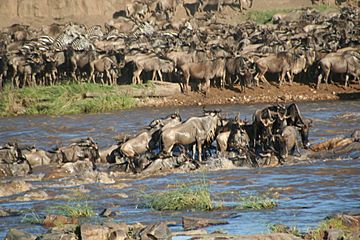Migration (ecology) facts for kids
Migration is when many members of a species move from one place to another. It's a natural part of the life cycle for many living things that move. While animal migration is the most well-known type, plants also migrate. This movement often happens in cycles, like every season or even every day. Species migrate to find better conditions, such as more food, safety from predators, chances to mate, or other good environmental factors.
Migration is most often seen as animals moving from one area to another. This includes birds, fish, and insect migration. However, plants can also be said to migrate. This happens when their seeds spread to new areas. If conditions like temperature or rainfall change, plants can grow in these new places, leading to things like forest migration.
Contents
How Living Things Migrate
Some species learn their migration routes by traveling with older members of their group for the first time. Other species have this information passed down through their genes. Even though different organisms use different signals to migrate, they often use similar cues.
Migrating organisms use environmental signals like how long the day is (called photoperiod) and weather conditions. They also use internal signals, like hormone levels, to know when to start their journey. They use senses like magnetoreception (sensing the Earth's magnetic field) to find their way. They also use olfaction (smell) to navigate their routes.
Why Migration Happens
The reasons for migration can change because major seasonal events are not always the same. When an organism moves from one place to another, its energy use and how fast it moves are connected. They are also linked to how safe the organism is.
If there is a natural barrier, like a mountain or a large body of water, along the migration path, the animal has a choice. It can use energy to cross the barrier directly. Or, it can use energy to go around it. If an organism is migrating to a place where there is a lot of competition for food or living space, it might need to migrate faster. This helps the organism survive and have babies, which is important for its species.
Types of Migration in Nature
Animal Journeys and Life Cycles
Animal migration is when individual animals move long distances. This usually happens every season. It is the most common type of migration in nature. It happens in all major animal groups. These include birds, mammals, fish, reptiles, amphibians, insects, and crustaceans.
Animals migrate for many reasons. These can include the local climate, how much food is available, the time of year, or for mating. To be a true migration, the movement should happen every year or season. It can also be a big change in habitat as part of an animal's life. For example, Northern Hemisphere birds fly south for the winter. Wildebeest move every year to find seasonal grazing areas. Young Atlantic salmon leave the river where they were born when they grow bigger.
Scientists can study migrations using tags like bird rings. They can also track animals directly with electronic devices. Before we understood animal migration, people made up stories. For example, some believed that barnacle geese grew from goose barnacles.
Plant Movement and Seed Spreading

Plants can also be said to migrate. This happens because their seeds can spread to new areas. This allows plants to grow where the environment is right, based on things like temperature and rainfall. When these conditions change, the edge of where a plant species lives might move. So, the plant can be said to migrate, like in forest migration.
How Migration Affects Ecosystems
When a species migrates to a new community, it can change how different species interact. If a migrating species is very common in its new home, it might become the main food source for a local predator. This means other local species become less important as prey. This new food source (the migrants) can make the predator's population grow. This can then affect the populations of its other prey when the migrating species leaves.
If a local species has less food because of seasonal changes, its population might decrease. This can create an opportunity for a new species to migrate there. The decrease in the local species' population leaves more food available. Migrating species can also carry diseases over long distances from their original homes.
See also
 In Spanish: Migración para niños
In Spanish: Migración para niños
- Great American Interchange, a time when animals moved between North and South America when the Isthmus of Panama formed.
- Human migration, when people move from one area to another.


